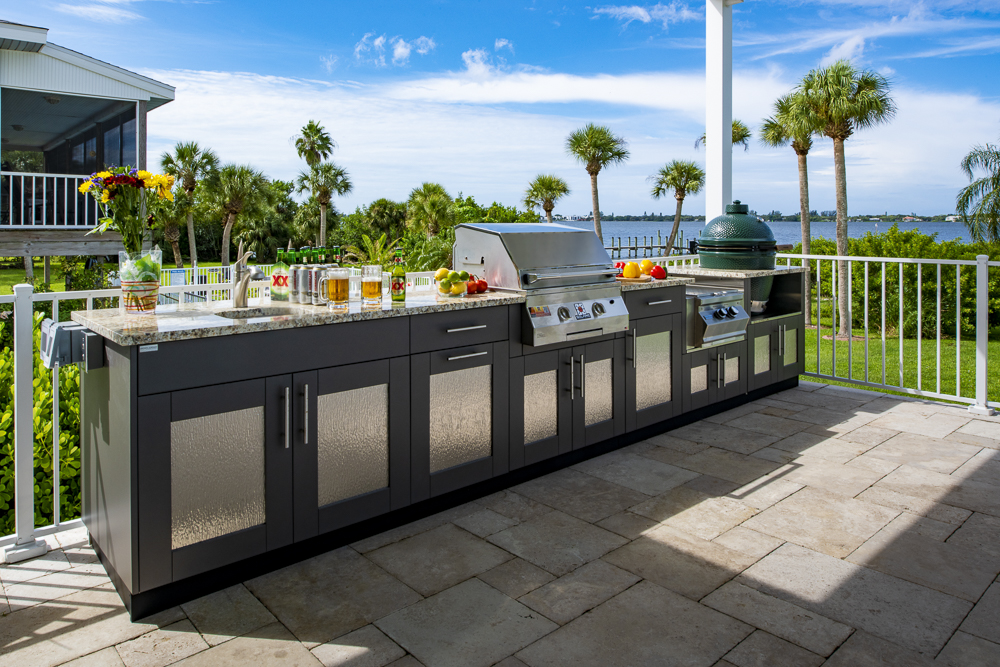Stainless steels are iron alloys mixed with chromium, rendering them an incredibly durable and heavy-duty material. For a material to be considered stainless steel, at least 10.5% of the molecular make-up must be chromium. The two most common grades of stainless steel for outdoor kitchens are 304 and 316 (marine grade) due to their strength. The grades are determined by their alloy composition, although both are high-quality and durable options for your outdoor kitchen appliances. While visibly indistinguishable, the chemical composition differs, making each grade more useful in certain applications.
All 300-grade stainless steels are austenitic (non-magnetic), rather than ferritic (magnetic). This refers to their grain structure. Most steels have a body-centered cubic grain structure, while austenitic steels have a face-centered cubic structure, meaning their atomic makeup allows them to be even more ductile and heat resistant than conventional types of stainless steels.
304 Stainless Steel
304 is the most common grade of stainless steel and is found in most appliances. While it is oxidation resistant, it can be corroded by chloride and salt substances. It is commonly used in kitchen equipment, cutlery, pipes and tubing, and military vehicles.
316 Stainless Steel
316 stainless steel is typically found in marine vessels and chemical storage units. It is highly durable, easy to clean and weld, and it is corrosion-resistant and heat-resistant. 316 contains several variations, such as 316L, which contains less carbon than 316. As a result, 316L resists even higher temperatures and higher levels of corrosion than 316, but it is more susceptible to damage from acid.
304 vs. 316 Stainless Steel
While the main alloys in 300 grade stainless steel are chromium and nickel, other additional alloys can include manganese, titanium, aluminum, copper, nitrogen, phosphorus, selenium, and molybdenum. The key alloy that distinguishes 304 from 316 is the addition of 2% molybdenum in the 316. Molybdenum provides a high resistance to heat, salt, and other chemicals in environments that are rich in salt air, giving 316 stainless the distinction of being “marine grade”. For this reason, 316 is invaluable for industries and appliances that regularly engage in salt or saltwater, and it is typically marketed as a marine metal for its use in wet weather and seawater conditions.
Should I Use 304 or 316 for My Outdoor Kitchen Cabinetry?
If you live in a coastal area, 316 is recommended for your outdoor kitchen cabinetry due to its corrosion resistance in salty areas. In other environments – the desert, the mountains, in the city, or in a suburban backyard – 304 is the way to go. Truthfully, the majority of appliance and grill manufacturers use 304 grade stainless steel – even in coastal areas – provided the steel is regularly cleaned, maintained, or kept covered. 304 tends to be less expensive than 316 as well, and it is more than adequate in most outdoor kitchen applications.
It is also important to note that stainless steel is not stain proof; it is stainless. Consequently, regardless of whether you use 304 or 316, exposed stainless steel (no powder coating) requires maintenance. The addition of molybdenum (in marine grade stainless steel) only retards corrosion – it does not stop it.
Why Add Powder Coating to Stainless Steel?
In order to truly fight corrosion, Brown Jordan Outdoor Kitchens recommends powder coating your outdoor kitchen cabinets regardless of the grade of stainless you decide. A powder coat finish is highly recommended for color customization, durability, and to minimize maintenance. Choose from a palette of 10 Brown Jordan-exclusive colors and 7 realistic wood grain finishes to protect your stainless cabinets and provide a vibrant, long-lasting finish.
Powder coating makes your outdoor kitchen virtually maintenance-free from a cleaning perspective, as well as protection from weather and everyday wear-and-tear. A bare stainless steel surface highlights unsightly blemishes, such as fingerprints, streaking, smudges, dust, and dirt. A powder coat finish requires only water and a mild detergent to clean and provides a protective seal from corrosion, rust, scratches, and stains.
Over 85% of the kitchens manufactured in our Connecticut factory are powder coated. In the 20 years, we have been delivering these kitchens, we have virtually no instances of rust or degradation on powder coated surfaces.
When considering long-term value, stainless steel outdoor kitchens are the best investment. For any additional questions or advice on your project, reach out to our in-house design team at 203-626-5625 or contact us and we’ll be in touch!

